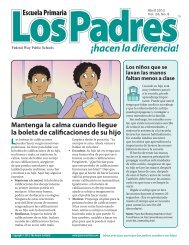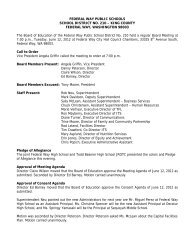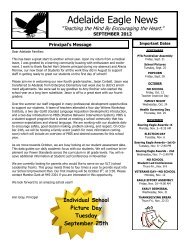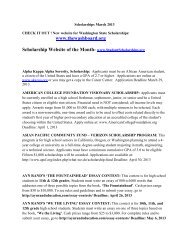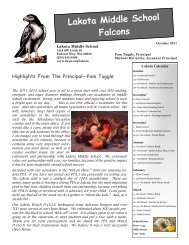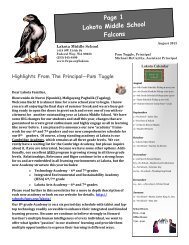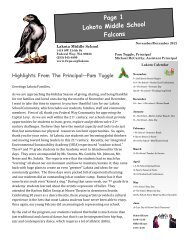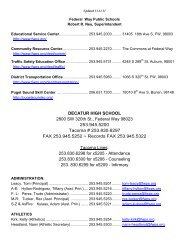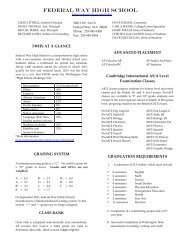You also want an ePaper? Increase the reach of your titles
YUMPU automatically turns print PDFs into web optimized ePapers that Google loves.
<strong>Unit</strong> 3 <strong>Notes</strong>: <strong>Mutations</strong><br />
Remember that:<br />
• A genetic change in a population of organisms from one generation to the next<br />
generation.<br />
• Evolution leads to differences in populations.<br />
• Evolution explains the origin of all of the organisms that exist today or have ever<br />
existed.<br />
A Refresher On The Source of Variation<br />
Where does genetic variation come from?<br />
1. Meiosis:<br />
2. Sexual Reproduction:<br />
3. Crossing over:<br />
4. Segregation & Independent Assortment<br />
Crossing Over<br />
1.<br />
2.
Genetic Variation<br />
• Without genetic variation, some of the basic mechanisms of evolutionary change<br />
CANNOT operate.<br />
• Genetic Variation allows for faster adaptation and evolution than genetically<br />
similar populations.<br />
There are 3 primary sources of genetic variation:<br />
1. 2. 3.<br />
<strong>Mutations</strong><br />
DEFINITION:<br />
1.<br />
2.
There are 5 types of DNA mutations:<br />
1.<br />
2.<br />
3.<br />
4.<br />
5.<br />
Substitution <strong>Mutations</strong>:<br />
DEFINITION:<br />
Original Strand<br />
Mutated Strand<br />
(highlight the<br />
mutation)<br />
CTGGAG<br />
1.<br />
Example:<br />
Sickle Cell Anemia<br />
• Inherited disease of red blood cells<br />
• Symptoms: pain, fatigue, breathlessness, rapid heart<br />
rate<br />
• Prognosis: Incurable. Some patients may live into their<br />
50’s
Insertion <strong>Mutations</strong>:<br />
DEFINITION:<br />
Original Strand<br />
CTGGAG<br />
Mutated Strand<br />
(highlight the<br />
mutation)<br />
Again...Different codon makes a different protein<br />
Ex. Huntington’s Disease<br />
• Huntington's disease is an inherited disorder in which some brain cells waste<br />
away, or degenerate.<br />
• Symptoms: Uncontrollable body movements, Dementia, Disorientation.<br />
• Prognosis: Incurable. Death by 15-20 years old.<br />
Deletion <strong>Mutations</strong>:<br />
DEFINITION:<br />
Original Strand<br />
CTGGAG<br />
Mutated Strand<br />
(highlight the<br />
mutation)<br />
Again...Different codon makes a different protein<br />
Cri du Chat Disease<br />
• Cri du Chat disease is a genetic disorder caused by a missing piece of<br />
chromosome 5.<br />
• Symptoms: Severe mental, speech, and motor delays.<br />
• Prognosis: Many will have normal life expectancy.
Frameshift <strong>Mutations</strong>:<br />
DEFINITION:<br />
Original Strand<br />
THE FAT CAT SAT ONA RAT<br />
Mutated Strand<br />
(highlight the<br />
mutation)<br />
Again...Different codon makes a different protein<br />
Ex. Tay-Sachs Disease (bad) or Nylonase (good)<br />
Tay-Sachs Disease<br />
• Inherited as a recessive gene<br />
• A relentless deterioration of mental and physical abilities<br />
• Usually results in death by the age of four.<br />
Nylonase<br />
• Some mutations are beneficial.<br />
• Nylonase: enzyme produced by bacteria that eat nylon (a man-made product).<br />
• Potential as an environmental clean-up agent for spills of man-made chemicals.<br />
• But nylon is only 60 years old. Evolution in Action?<br />
Gene Flow (aka Migration)<br />
DEFINITION:<br />
a. c.<br />
b. d.
Sexual Reproduction<br />
1.<br />
1.<br />
Passing on mutations<br />
2.



